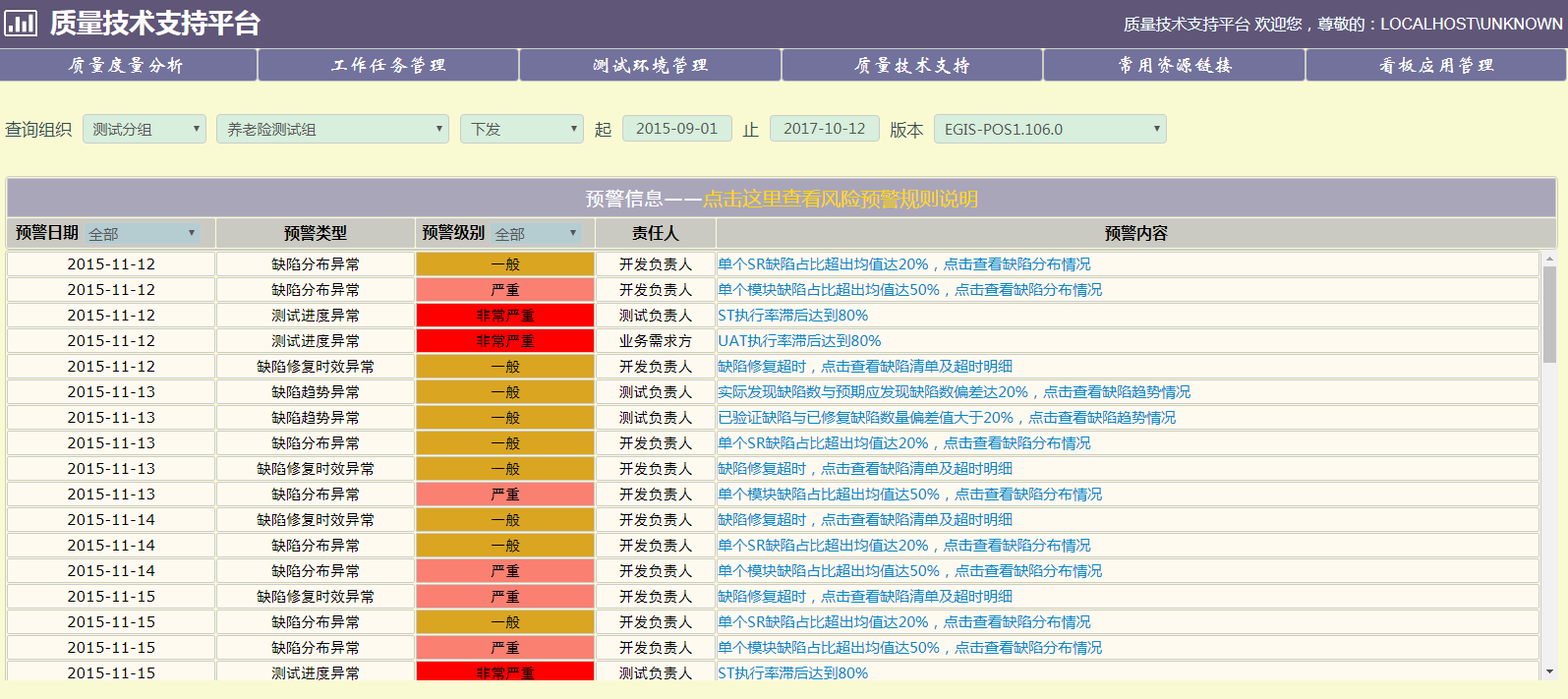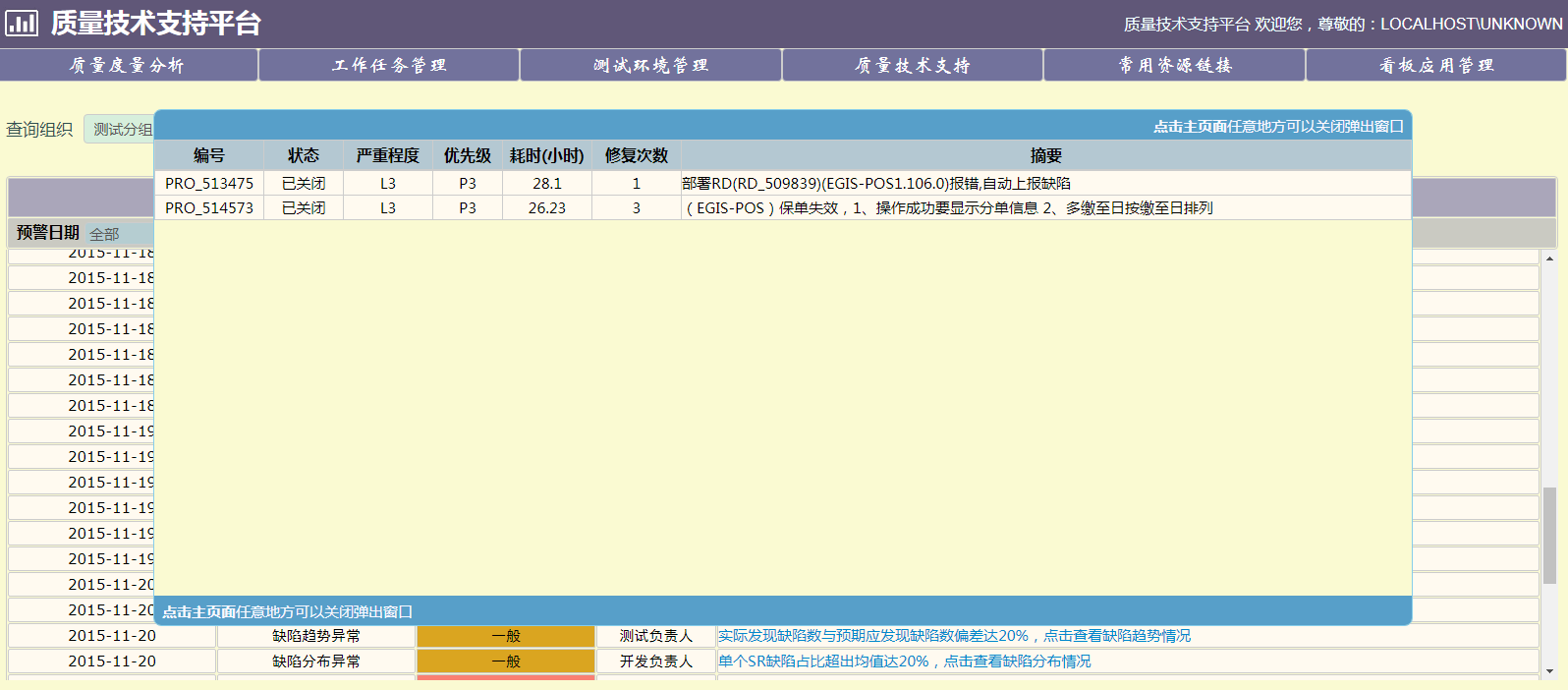-
缺陷增长模型 at October 19, 2017
精英不用管,自组织、自管理啊,领导都是端茶送水的角色
-
利用 Python 进行对智能灯具固件升级 at October 19, 2017
赞,啥牌子、型号的灯呢?
话说,不能贴代码么,非要截图 -
缺陷增长模型 at October 19, 2017
这我知道,好像后面又跳了
-
缺陷增长模型 at October 19, 2017
最后还是要鸣谢一下,当年 marvell 测试经理张昊翔,现在去哪里也不知道了
做这些还是来自他 chinatest2012 的演讲,可惜现在 TID 大会演讲的水平已经不复当年了,说明测试真的就那么点事可说,技术发展都是被动的,而非领跑 IT 行业~ -
缺陷增长模型 at October 19, 2017
只是管理效率、便利性和准确性的提升,对于一线帮助不大,你可以那这个数据透视的结果要求他们(包括开发、产品、测试)在哪里加强测试、在什么阶段要抓紧投入等等,而想要他们自己理解这些,估计就比较难了,除非是精英团队……而精英团队才不会用这个咧~
-
# 每日一道面试题 # 统计每个班的男生女生分别有多少人? at October 19, 2017
case when 写法,时间换空间,牺牲 CPU 时间用于判断和计算
left join 写法,空间换时间,两个查询结果在内存中 sort附 SQL:
SELECT a.classid, IFNULL(a.male_num, 0) AS male_num, IFNULL(b.famale_num, 0) AS famale_num FROM ( (SELECT classid, COUNT(*) AS male_num FROM student WHERE gender = 'M' GROUP BY classid) a LEFT JOIN (SELECT classid, COUNT(*) AS famale_num FROM student WHERE gender = 'F' GROUP BY classid) b ON a.classid = b.classid ) GROUP BY a.classid ; -
# 每日一道面试题 # 谈谈你职业生涯中遇到最难的 BUG at October 19, 2017
我最多问印象最深刻的 BUG,最难这种我觉得是伪命题
BUG 找到了,难道不解决?解决了不知道什么原因、怎么解决的?都知道了还有什么难的,了解过后都不会觉得多难~
要说难这种情况,大多在测试开发自己开发自己测试,搞 1、2 天找不出问题根因,那才叫难呢……虽然最后很可能只是一个引号敲错了 -
来甩个锅,这些问题都不是我的 at October 17, 2017
可惜规则不能定制化,全都按照阿里的路子来,有点不大灵活……确切的说是很不灵活
-
来甩个锅,这些问题都不是我的 at October 16, 2017
-
来甩个锅,这些问题都不是我的 at October 16, 2017
https://testerhome.com/topics/10451
realtime-report 和 reportng 是我自己改写过的
-
发现一个好玩的东西:realtime-report at October 16, 2017
不必为了一句话之失而拼命挽尊吧,阁下是谁我猜得出七八分,或许你还可能面试过我,跟我讨论 MBT 的核心难点在于脚本如何生成并且不等回答就直接否定说你们肯定解决不了这个问题的那位?阁下网上网下语气倒是一致得很啊。不过不得不承认招行的技术还是超级厉害的~
我保险、银行、证券行业算是都混过,像招行这个技术水平的真的没有,所以,不用揪着一句玩笑话就上火,就算是真做这个鬼,肯定也不敢卖给你们的
-
[北京] 美团 招聘业务测试技术专家 at October 13, 2017
3.3+?
-
匿名讨论一下自己的状况吧 at October 13, 2017
干嘛明年跳,现在就来啊,本司欢迎你,我这人就不怕 XDJM 们弱,就怕不想学、不会学
-
请教:定位 form 表单元素 Unable to locate element at October 13, 2017
用 chrome 打开调试工具(F12),进入 console,输入:
alert(window.document.getElementById("mobile_file_url").getAttribute("value")); 如果你的网页有用jquery,那就这样写: alert($("#mobile_file_url").val()); 在jquery的前提下,如果这一句没结果,那就试试: alert($("#mobile_file_url").eq(0).val()); 如果有了结果,那就说明id使用重复,js或者jsp编译就应该有报错才对,可能被IDE给忽略掉了,找开发解决如果以上操作,第一步弹出窗口有内容(就是那个 zip 的 url),那说明文档结构是没问题的,如果最终没有结果,那么还是要找开发去看,到底用了什么控件,是 flash 啊还是 SWFUpload 之类的什么鬼~
-
请教:定位 form 表单元素 Unable to locate element at October 12, 2017
type=“hidden” 只是一个 “貌似为了” 防跨站攻击的隐藏域,用来记录一个随机串的吧,肯定于此无关,因为这根本不是 form 的属性,而是 form 的一个 childobject 而已
不妨换 xpath 试一下,如果 OK 了,说明前端有小 bug 或者结构太过复杂导致按照 id 无法查询到
-
selenium: 死磕页面跳转,主页 - 登录页 - 主页 at October 12, 2017
单步等待的 API 封装,一般不赞成这么用
/** * Description: set element locate timeout.</BR> * 内容描述:设置对象查找超时时间. * * @param seconds * timeout in timeunit of seconds. */ protected void setElementLocateTimeout(int seconds) { driver.manage().timeouts().implicitlyWait(seconds, TimeUnit.SECONDS); } /** * wait for the element visiable in timeout setting</BR> * 在指定时间内等待,直到对象可见。 * * @param by * the element locator By * @param seconds * timeout in seconds */ protected boolean waitForElementVisible(By by, int seconds) { try { setElementLocateTimeout(seconds); WebDriverWait wait = new WebDriverWait(driver, seconds, stepTimeUnit); return wait.until(ExpectedConditions.visibilityOfElementLocated(by)) != null; } finally { setElementLocateTimeout(maxWaitfor); } } /** * wait for the element visiable in timeout setting</BR> * 在指定时间内等待,直到对象可见。 * * @param element * the element to be found. * @param seconds * timeout in seconds. */ protected boolean waitForElementVisible(WebElement element, int seconds) { try { setElementLocateTimeout(seconds); WebDriverWait wait = new WebDriverWait(driver, seconds, stepTimeUnit); return wait.until(ExpectedConditions.visibilityOf(element)) != null; } finally { setElementLocateTimeout(maxWaitfor); } } /** * wait for the element not visiable in timeout setting</BR> * 在指定时间内等待,直到对象不可见。 * * @param by * the element locator. * @param seconds * timeout in seconds. */ protected boolean waitForElementNotVisible(By by, int seconds) { try { setElementLocateTimeout(seconds); WebDriverWait wait = new WebDriverWait(driver, seconds, stepTimeUnit); return wait.until(ExpectedConditions.invisibilityOfElementLocated(by)) != null; } finally { setElementLocateTimeout(maxWaitfor); } } /** * wait for the element present in timeout setting</BR> * 在指定时间内等待,直到对象出现在页面上。 * * @param by * the element locator. * @param seconds * timeout in seconds. */ protected boolean waitForElementPresent(By by, int seconds) { try { setElementLocateTimeout(seconds); WebDriverWait wait = new WebDriverWait(driver, seconds, stepTimeUnit); return wait.until(ExpectedConditions.presenceOfElementLocated(by)) != null; } finally { setElementLocateTimeout(maxWaitfor); } } /** * wait for the element clickable in timeout setting</BR> * 在指定时间内等待,直到对象能够被点击。 * * @param by * the element locator By * @param seconds * timeout in seconds */ protected boolean waitForElementClickable(By by, int seconds) { try { setElementLocateTimeout(seconds); WebDriverWait wait = new WebDriverWait(driver, seconds, stepTimeUnit); return wait.until(ExpectedConditions.elementToBeClickable(by)) != null; } finally { setElementLocateTimeout(maxWaitfor); } } /** * wait for text appears on element in timeout setting</BR> * 在指定时间内等待,直到指定对象上出现指定文本。 * * @param by * the element locator By * @param text * the text to be found of element * @param seconds * timeout in seconds */ protected boolean waitForTextOnElement(By by, String text, int seconds) { try { setElementLocateTimeout(seconds); WebDriverWait wait = new WebDriverWait(driver, seconds, stepTimeUnit); return wait.until(ExpectedConditions.textToBePresentInElementLocated(by, text)) != null; } finally { setElementLocateTimeout(maxWaitfor); } } /** * wait for text appears in element attributes in timeout setting</BR> * 在指定时间内等待,直到指定对象的某个属性值等于指定文本。 * * @param by * the element locator By * @param text * the text to be found in element attributes * @param seconds * timeout in seconds */ protected boolean waitForTextOfElementAttr(By by, String text, int seconds) { try { setElementLocateTimeout(seconds); WebDriverWait wait = new WebDriverWait(driver, seconds, stepTimeUnit); return wait.until(ExpectedConditions.textToBePresentInElementValue(by, text)) != null; } finally { setElementLocateTimeout(maxWaitfor); } } -
mvn install ERROR: 找不到符号 at October 12, 2017
应该是,依赖的 JUnit、TestNG,把
<scope>test</scope>都删掉就行了 -
selenium: 死磕页面跳转,主页 - 登录页 - 主页 at October 12, 2017
参考一下:http://www.it1352.com/313066.html
实际操作起来,我发现其实这种操作在【效果上】还是阻塞的,并非异步
为什么呢?换个角度思考,有了这个 timeout,你在下一个 page 加载完成之前的任何操作(包括断言),也会有同样的超时设置作用于对你的 element 的加载等待,除非你故意在下一步操作之前把超时时间设置为 1s 或者更短~
所以我在脚本中基本不动这个设置,只有在初始化的时候通过全局设置一下,结合自己系统、环境的性能表现即可。 -
缺陷增长模型 at October 12, 2017
嗯,连测试工程师这个岗位都撤消了还说啥呢
-
缺陷增长模型 at October 12, 2017
链接: https://pan.baidu.com/s/1i5qwsVN
密码: ddf8 -
缺陷增长模型 at October 12, 2017
我再说一次我去蚂蚁面试的事情,第二次去蚂蚁面试的时候面试题就有一张累积缺陷趋势图,让我来说一下这个项目有什么问题,当时我惊叹于这帮互联网屌丝居然也懂我传统业务的管理办法……那时候开始我以为阿里在这块有一整套的评估和监控体系在实行,现在看你的描述,应该也只是某些团队才会有吧。
-
缺陷增长模型 at October 12, 2017
按照我的经验三五个 release 是要的,然后开始预测,然后分析、优化参数,拍拍脑袋瞎估算一下,稳定下来至少要:
- 团队人数、任务量稳定
- 扣腚的团队人数 8 人以上为佳,SRS 至少每个 release 要达到 5 个以上吧
- 但是新项目、产品研发,我一般第一个迭代上线之后就会立刻开始下一个迭代的计算,拿整个测试团队的平均参数水平来拟合,所以偏差难免会大点,但是越早开始,后面越早贴近真实情况
每个团队的业务类型、复杂度不一样,即便是同样的开发量,缺陷密度也不一样,所以,参数要具体到每个产品或者业务系统,分析的维度也可以多元化:按产品、按产品的 release、按开发团队、按测试团队……最后在一维分析的基础上再做二维、三维的分析,比如加上时间周期来看整体的趋势,这样在全年工作衡量乃至考核打分的时候都有点参考价值(这是大 M 的事)。
-
selenium: 死磕页面跳转,主页 - 登录页 - 主页 at October 12, 2017
看样子你还是没好好琢磨透 webdriver 怎么工作的啊,给你个样例你看下:
每一步操作,工具都会自动等到你设置的超时时间(pageLoadTimeout、implicitlyWait)过了才会继续判定为失败,在此时间内会自动轮询检查的
对 ajax 局部刷新,一样有效@Override public void startWebDriver() { cleanBrowserProcess(); try { initWebDriver(); driver.manage().timeouts().pageLoadTimeout(maxLoadTime, TimeUnit.SECONDS); driver.manage().timeouts().setScriptTimeout(maxWaitfor, TimeUnit.SECONDS); driver.manage().timeouts().implicitlyWait(maxWaitfor, TimeUnit.SECONDS); driver.manage().window().maximize(); } catch (Exception e) { LoggerUtils.error(e); throw new RuntimeException(e); } } -
缺陷增长模型 at October 12, 2017
丑便丑了,我再晒一图,我一直引以为傲的:


-
缺陷增长模型 at October 12, 2017
一个比较初级的版本供参考,说明:
- 基础配置数据需要自己灌(劝你别费劲了)
- 存储过程居然都在 mysql 里面(这个锅我不抗)
- 前后端分离没做干净,所以有些页面无法访问
- 地址:https://github.com/fudax/sqcs